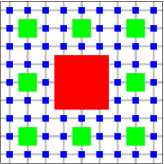SimulationTools
for Mathematica
- About
- Features
- Documentation
- Codes
- Download
- Support
- Development
SimulationTools code support
SimulationTools contains direct support for reading the output
data from many simulation codes and data formats. Many of the
supported codes are based on the
Cactus infrastructure,
including many from the Einstein Toolkit used for
Numerical
Relativity.
SimulationTools is modular, and has been designed to make it
easy to add support for additional Cactus and non-Cactus codes.
Typically, SimulationTools provides a low-level interface for
reading the output data from a code, handling file-name and
parsing issues, as well as a high-level interface in the
domain-language of the user. Where several codes generate
equivalent data (for example PunctureTracker and MinTracker), an
abstraction has often been built on top (Trackers) so that codes
can be written which work with simulations utilising any of the
underlying codes without having to support each explicitly.
Since HDF5 output from grid
functions is also supported, any Cactus code which outputs grid
function data can also have this data read into
SimulationTools.
SimulationTools contains explicit support for the following
codes:
Cactus

An open-source framework for numerical
simulation emphasising high-performance computing and
collaborative code development
http://cactuscode.org
- Read parameters by name from parameter files in
simulation output directories
- Functional interface to some parameters: e.g.
SimulationFinalTime["mysim"] reads parameter
Cactus::cctk_final_time
- Functions to determine grid structure min/max/spacing use
CoordBase parameters
- Import IOASCII
1D data and IOHDF5
HDF5 files, automatically merging together components from
different processes
- Read mesh-refined 1D CarpetIOASCII
output files, automatically combining data from different
processes
- Read CarpetIOHDF5
1D, 2D or 3D data, automatically merging output from
different processes, including support for refinement levels
and multiblock data
- Use a functional interface to
access CarpetRegrid2
mesh-refinement parameters
Simulation Factory

A uniform interface and workflow manager
for running simulations on diverse HPC machine
http://simfactory.org
- Read simulation properties such as the number of cores
used for a simulation from SimFactory output
- Transparently merge files from the different segments
(“restarts”) of a SimFactory simulation when the data is
loaded
- Can load Multipole
mode files in ASCII or HDF5 format. Also makes data for Psi4
available through the “Waveforms” interface.
- Uses TwoPunctures
metadata file to obtain information about initial data of
binary black hole simulations
- Reads PunctureTracker
output files and makes the data available through the
“Tracker” and “Binary” interfaces
- Functional interface to QuasiLocalMeasures
horizon spins, provided in the “BlackHole” interface.
- Functional interface to AHFinderDirect
horizon data, also exposed in the “BlackHole” interface
Miscellaneous
- Read SystemStatistics output
files using a functional interface to memory and swap usage
etc.
- Read data from simulations in
the Numerical Relativity Data
Format, a standard for interchanging data between
NR codes, using the same functional interface as data from
other simulation formats.



